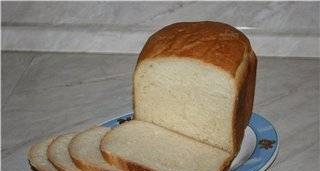Kitfort KT-113 induction hob
Available in five colors:
Kitfort KT-113-1, blue
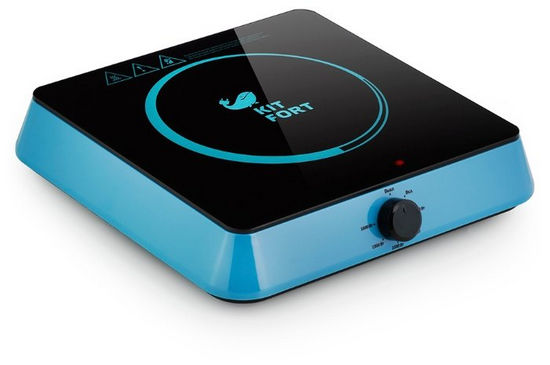
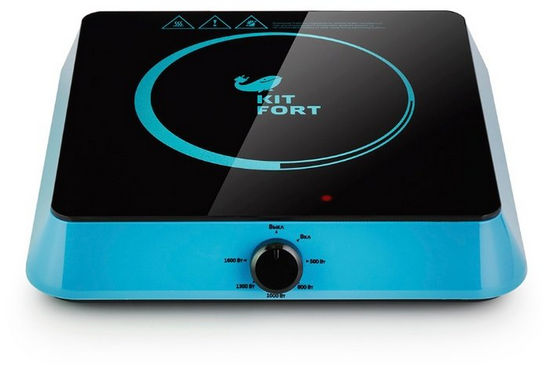
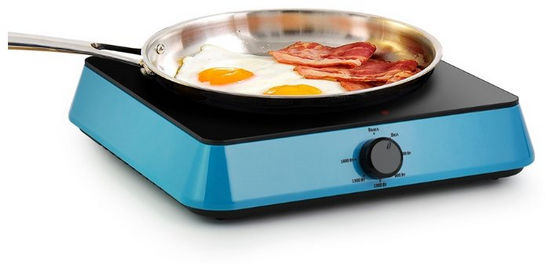
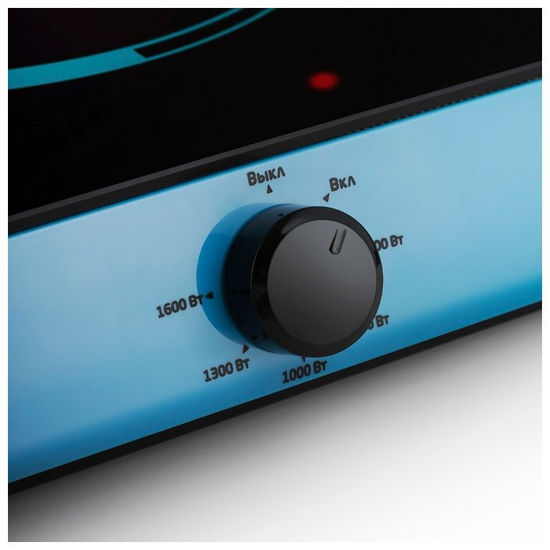
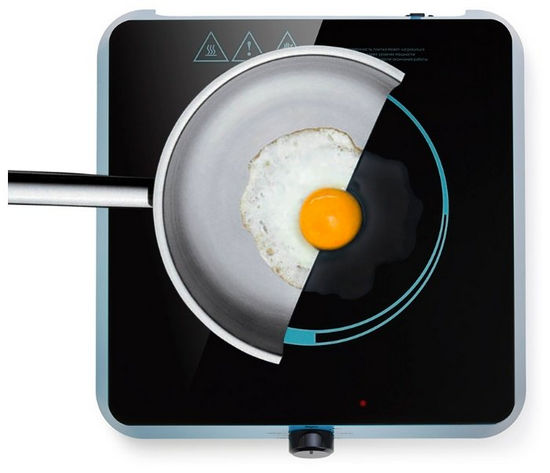
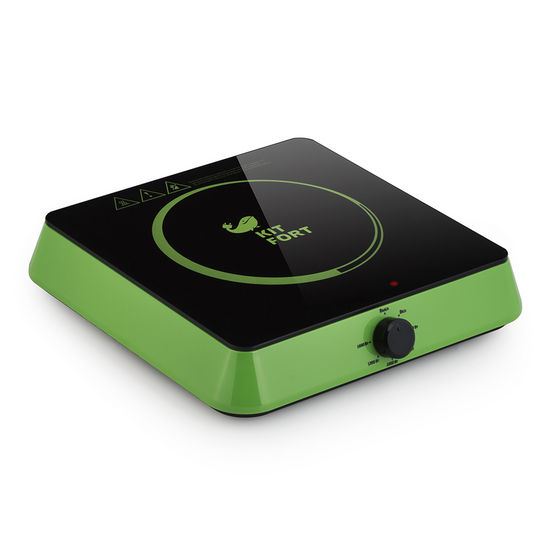

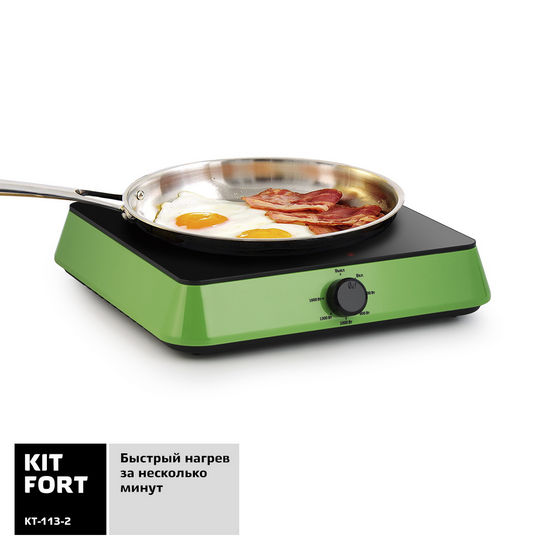
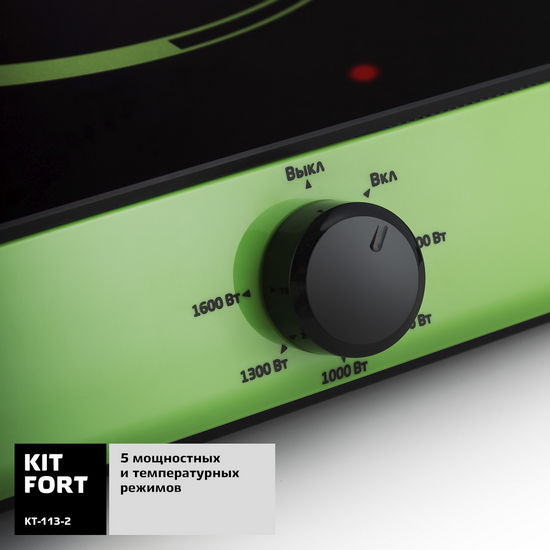
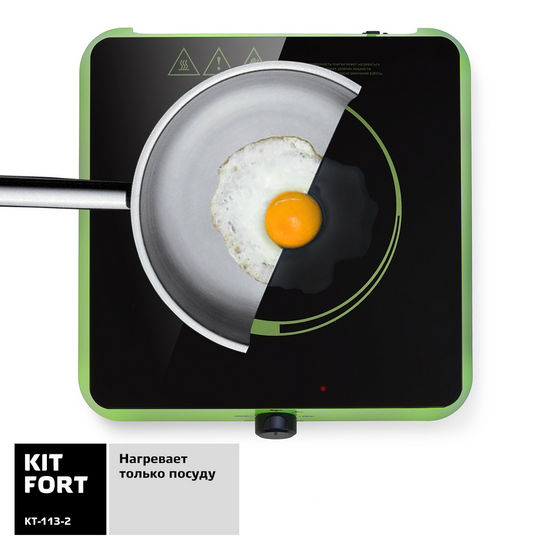
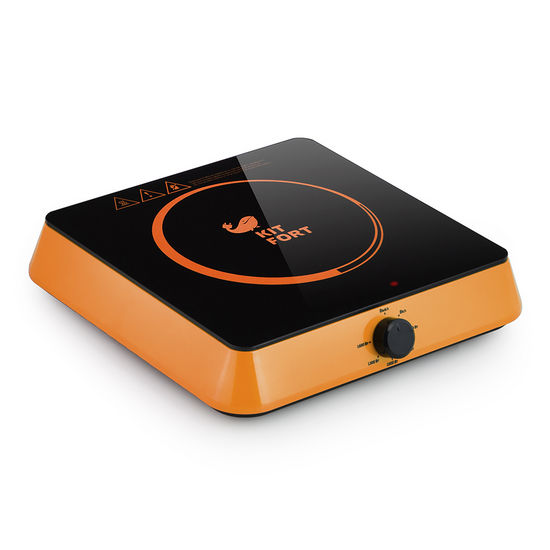

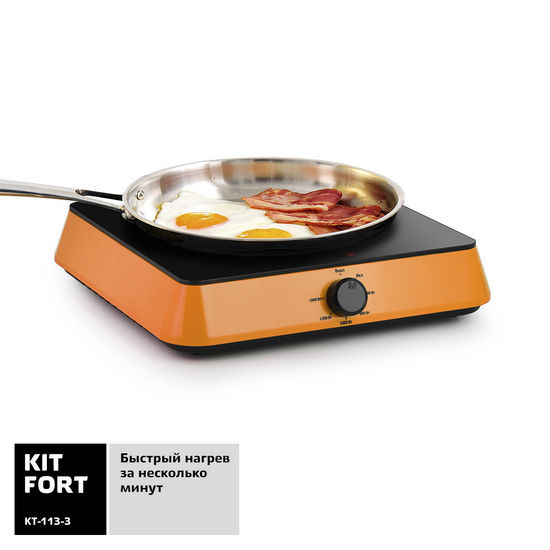
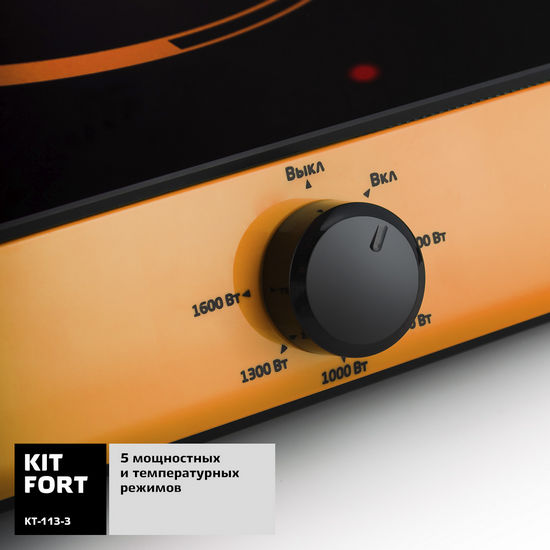



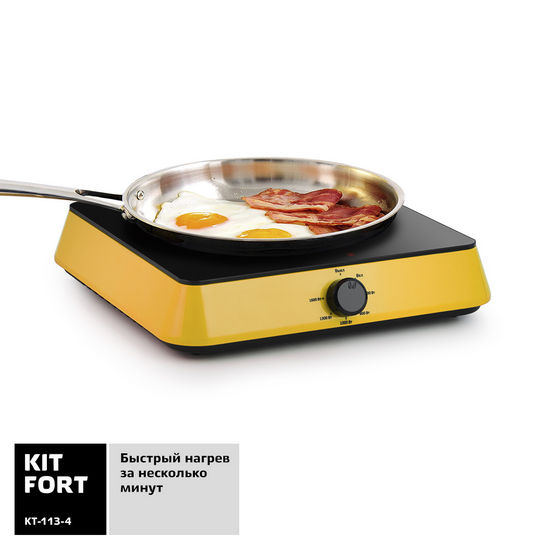
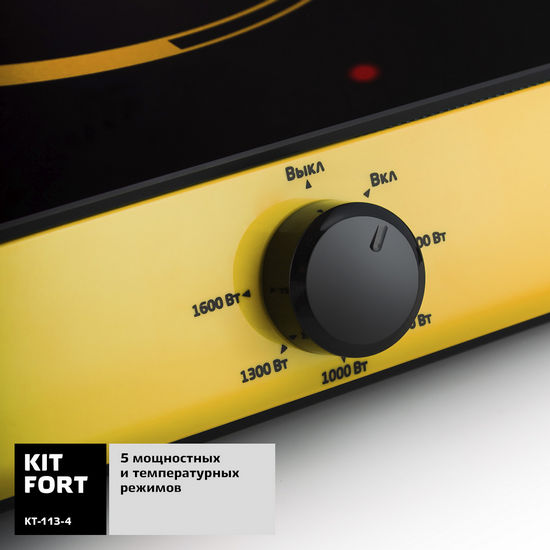



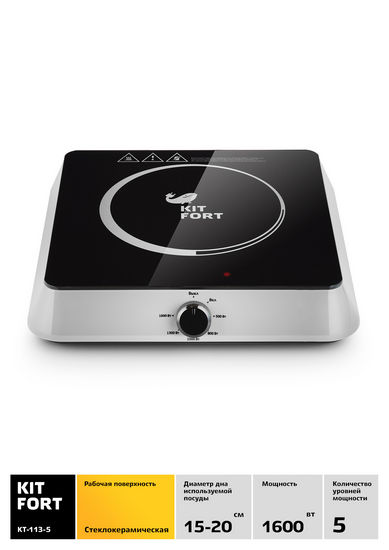
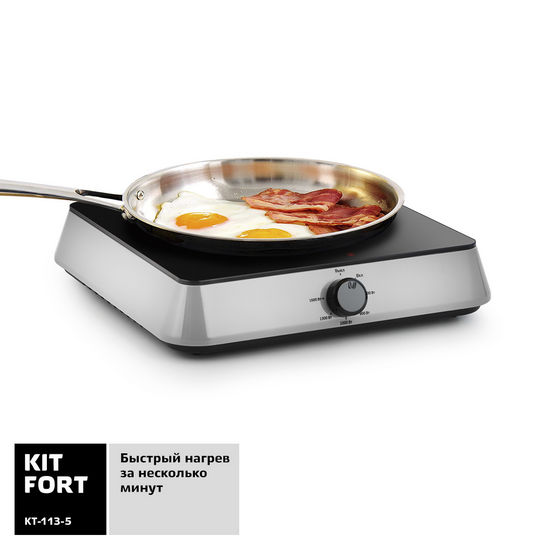
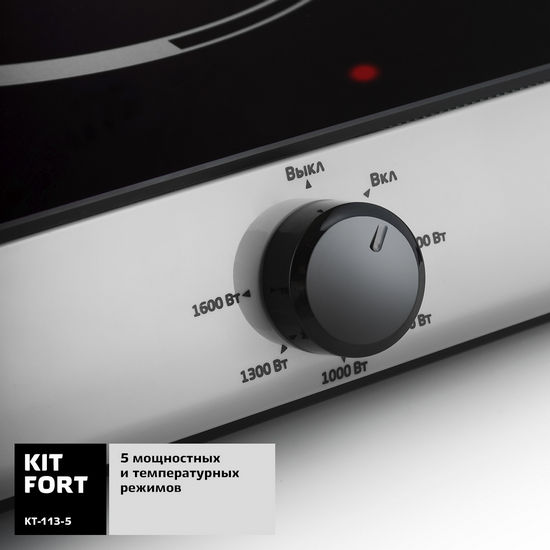

- glass-ceramic surface
- 5 power modes
- 90% efficiency
- cooks 2 times faster than gas and electric stoves
- diameter of the bottom of the dishes used: 12-18 cm
Voltage: 230 V, 50 Hz
Power: 1600 W
Device size: 290 x 303 x 66mm
Package size: 363 x 122 x 376mm
Cord length: 1.32 m
Net weight: 1.95kg
Gross weight: 2.46 kg
Equipment:Induction cooker - 1 piece
Operation manual - 1 piece
Warranty card - 1 piece
Collectible magnet - 1 piece *
* optional
Kitfort KT-113 induction cooker is one of the new environmentally friendly kitchen appliances. It is controlled by a control knob, which is very convenient to select the power. The Kitfort KT-113 tiles use modern technologies that allow you to cook tasty, fast and absolutely safe. The induction hob practically eliminates the possibility of getting burned, since the work surface hardly heats up during cooking, and the efficiency of the hob is 90%, which is much higher than that of other types of electric stoves, so it does not heat up the air in the room during cooking.
General informationThe induction hob is one of the newest eco-friendly kitchen appliances developed according to the latest European, American and Japanese technologies. The main components of the cooker, such as the IGBT, CPU, and integrated circuit, are supplied by Siemens, Toshiba and Motorola, which are the industry leaders in advanced electronics. Kitfort KT-113 induction cooker meets the requirements of the state standard and is suitable for cooking any dishes. In a short time from the moment of switching on until the beginning of boiling, the heating efficiency can reach 94%. Thanks to a special security system based on a microcontroller, the cooker is highly secure and reliable. Since the induction hob works to eliminate the generation of fire, smoke and burning, its use avoids the safety problems commonly associated with cooking, and many customers prefer this appliance.
This induction hob will help make your family's life safer and healthier and bring cleanliness to your kitchen.
Induction hob working principle
Rising heat flux
The principle of operation of an induction cooker is based on induction heating, which is the heating of bodies in an electromagnetic field due to the thermal action of eddy electric currents flowing through the heated body and excited in it due to the law of electromagnetic induction.
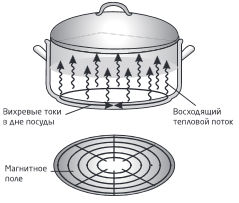
An induction hob has a coil (inductor) made of stranded wire with insulated conductors. When an alternating current of high frequency passes through the coil, an alternating electromagnetic field is created in and around it. If you place a saucepan with a bottom made of ferromagnetic materials on an induction hob, then the electromagnetic field will create an electric current in it, which will lead
to heat the material of the bottom of the pan (Joule effect). Unlike traditional electric stoves, where heating is carried out using a heating element, when using induction heating, heat is generated directly in the thickness of the bottom of the pan, and in this way the food is heated and cooked. In an induction cooker, there is no heat loss during its transfer from the burner to the cookware, which are present in a conventional electric cooker, since in this case the cookware in which the food is cooked is heated directly. In addition, the dishes are heated almost instantly, without the need to preheat the stove itself.If the pot is removed from the stove, the power transmission is immediately stopped. The induction hob does not heat up directly, but only from contact with hot cookware. In combination with the poor thermal conductivity of the glass-ceramic from which the top surface of the hob is made, this provides greater safety and high efficiency when compared to a conventional electric stove.
The induction hob has a very high efficiency (up to 94%), which significantly reduces energy costs. The table below shows the efficiency of various types of boards. As you can see, the efficiency of an induction cooker is significantly higher than that of other electric cookers.
The electronics of the cooker are controlled by a microprocessor and have a high degree of safety for people and the environment.
Due to the physical characteristics of induction heating, the working surface of the stove does not heat up during cooking. Slight heating of the surface is possible only due to contact with the heated bottom of the cookware. But even in such cases, a few seconds after removing the dishes, the stove becomes cold. This property is especially important in homes where there are small children who like to learn new things by touch.
Induction hob safety
This induction hob is fully compliant with the current safety and EMC standards. However, persons using pacemakers are not advised to use this cooker as it cannot be guaranteed that all such devices on the market meet the above standards. It is also possible that people with other devices, such as hearing aids, may experience some discomfort when using an induction hob.
The electromagnetic radiation generated by the induction cooker lies in the frequency range 20-100 kHz. For comparison, a microwave (microwave) oven radiates at a frequency of 2.4 GHz - 10,000 times higher. The frequency range 20-300 kHz refers to the mid-frequency range of radio waves (the corresponding wavelength is 0.5-10 km).
In normal operation, the inductor plane of the induction cooker is covered with the bottom of the cookware standing on the cooker, so all the energy of the electromagnetic field released by the inductor is absorbed by the cookware. If the absorption of the energy of the electromagnetic field suddenly disappears (for example, the pan is removed from the stove), then the electronics immediately turns off the generation of the field. The efficiency of absorbing electromagnetic radiation also decreases with distance. This is easy to see if you raise the pot above the burner. At a distance of about 3-5 cm from the work surface to the bottom of the pan, the energy absorption is reduced so much that the stove simply turns off and displays an error message. This behavior is facilitated by the configuration of the electromagnetic field, due to the relative position of the inductor and the bottom of the pan - together they constitute a high-frequency transformer. When there are no dishes on the surface of the stove, this means that there is no secondary coil, which is necessary for the operation of the transformer. As a result, the stove simply does not turn on.
As you can see, no radiation occurs in the surrounding space, which means that harmful effects are excluded, therefore the stove is safe for health.
Kitfort KT-113 induction cooker has overheating protection. If the bottom of the cookware is overheated and the temperature of the glass-ceramic surface reaches 320 ° C, the hob will turn off automatically. Also, the stove will turn off if the power transistor overheats (for example, if the ventilation holes are blocked).
The KT-113 plate can withstand voltage drops and can operate at both increased and decreased supply voltage, while the heating power changes insignificantly. Allowable voltage range: 150-260 V.
It is forbidden to connect the stove through thyristor and pulse voltage regulators, otherwise the stove may burn out together with the regulator.
Noises during induction hob operation
Induction heating technology is based on the heating of metal dishes by induced eddy currents generated by a high-frequency electromagnetic field. Under certain conditions, vibrations associated with the magnetostrictive effect can occur, which can cause the formation of quiet noise.
Low frequency hum, like a transformer, occurs when you cook at a high heating power level and is related to the amount of energy the induction hob supplies to the cookware. This noise will disappear or become quieter after you lower the power level.
Quiet buzzing... Occurs when the dishes are empty. It will disappear when you add water and food to the dishes. Also, the noise may depend on the geometric shape of the bottom of the pan.
Crackle... This noise is generated by dishes made from layers of different materials. It is caused by vibration that occurs at the junction of these layers. This noise is cookware-specific. It may vary depending on the amount and type of food you will be using to cook.
Fan noise... In order to function without interruption, the electronics must operate at a controlled temperature, so the induction hob is equipped with a fan. After the stove is turned off, the fan runs for some time to cool the heated electronic components.
These are all perfectly normal noises typical of induction heating technology. They do not indicate a malfunction.
For an induction cooker, cookware with a bottom made of ferromagnetic materials is suitable: steel, cast iron, enamel cookware, stainless steel cookware, as well as any other cookware designed for induction heating (usually such cookware has a special marking). It is easy to identify suitable cookware with a magnet - if it is magnetized to the bottom, such cookware will most likely work. However, the test with a magnet does not give a 100% guarantee that the cookware will fit, refer to the information from the cookware manufacturer.
The recommended bottom diameter is 12-18 cm, although it is possible to use pans of other diameters, up to 7 cm. Pans with a small bottom diameter are recommended to be placed in the center of the heating zone or slightly closer to the rear edge.
During cooking, the maximum diameter of the pan bottom is limited by the geometrical dimensions of the plate. Do not let the bottom fit over the control panel. Large pans can be pushed back a little. When frying, the operating temperature is much higher, so the maximum diameter of the bottom of the pan is limited by the size of the burner, and should not exceed 22 cm, otherwise, due to the high temperature of the pan, the plastic on the sides of the stove body may deteriorate.
When using large pans, it is desirable that they have a thick bottom to distribute heat evenly. The heating zone is limited by the diameter of the inductor, which is approximately 15 cm. If the bottom of the pan is larger, heat is transferred to its edges outside this diameter only through heat transfer through the thickness of the bottom. Therefore, when using a large-diameter, thin-bottomed frying pan, heating at the edges will be worse than in the middle. To avoid this, use a heavy-bottomed skillet. This circumstance does not matter when cooking or boiling water, since the temperature in the pan does not exceed 100 ° C, in addition, heat is transferred through the liquid by convection. Therefore, when cooking, a large-diameter saucepan may well have a thin bottom. When frying, the temperatures used are higher than during cooking, and there is no convection, therefore, the thickness of the bottom is of no small importance for an even distribution of heat over the area of the pan.
Cookware that is not magnetized is usually not suitable for induction cooking. Do not use heat-resistant glass, ceramic, copper, aluminum or non-magnetic stainless steel.Also, do not use pans with spherical, non-planar bottom or pans with legs.
If the cookware is not suitable for an induction hob or the bottom diameter is too small, the hob will beep and no heating will take place.
Plate KT-113 can withstand a weight of no more than 10 kg.
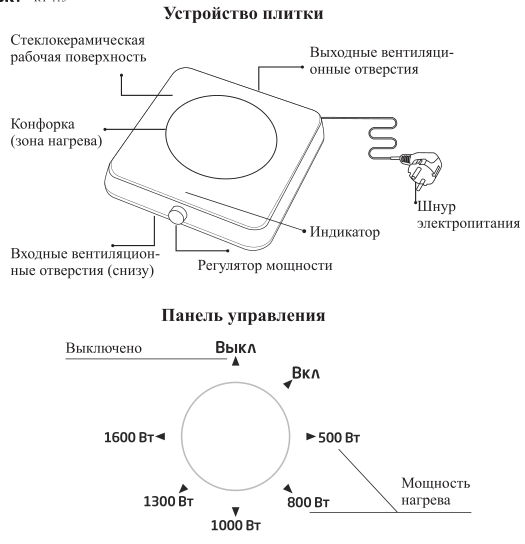 Preparation for work and use
Preparation for work and use
If you purchased the stove during the cold season, open the packaging, take out the stove and, without plugging it in, let it warm up to room temperature.
Place the plate on a flat, non-metallic surface. Check that the ventilation holes on the bottom and sides are not blocked.
It is forbidden to use the stove on any metal surfaces! Otherwise, there is a risk of damage to the plate.
Make sure there is at least 10 cm from the back wall to the wall to ensure proper ventilation. There must be at least 10 cm from the front of the hob to the edge of the surface to prevent accidental dropping of the appliance.
The stove is equipped with forced ventilation. Air is sucked in from below and exits from the back. Do not block ventilation openings. Do not place the stove on a piece of paper or a thin tablecloth, as they may suck and block the air inlets. For the same purpose, do not place paper napkins and pieces of paper next to the stove - they can be pulled under the stove by the air flow, and they block the air flow for ventilation.
1. Connect the hob to the power supply.
2. Place cookware with food on the hotplate.
3. Switch on the hotplate by turning the power control clockwise. Heating will start immediately.
4. Select the required cooking power.
5. To turn off heating, turn the power control counterclockwise to the “Off” position until you hear a click.
6. After use, turn off the hob and disconnect it from the power supply.
Display and error messages
If the stove is connected to the power supply, but the heating is off, the indicator does not light up. The indicator lights up continuously during heating. If an error occurs during heating (for example, there is no cookware on the hotplate), a periodic beep will sound.
When turning the stove on and off, as well as when adjusting the power, a sound signal is emitted.
The power is adjustable in steps from 200 W to 1600 W. When switching between power levels, a beep sounds. The control panel shows approximate power values for the respective power control positions.
At low powers (1000 W or less), heating is carried out in a pulse-periodic mode with a period of several seconds. This means that the heating turns on for a few seconds, and then turns off, and then cyclically. The pulse-periodic mode can manifest itself, for example, in the fact that the water in the pan will periodically boil, then not boil. This is a feature of the induction hob operation at low power levels. From a power of 1200 W and above, heating is carried out continuously.
The stove does not know how to maintain and set the temperature. But you can adjust the wattage to get the temperature you want. The correspondence of power steps in watts and degrees is shown in the table below. This correspondence is obtained by placing a certain average frying pan on the stove and measuring its temperature at each stage of heating. For a frying pan with a different diameter, the ratio will change slightly, but overall it reflects the correct picture.
Power, W Temperature, ° C
800 1000 1300 1600
140 160 190 240
If the cooker does not receive any commands for 2 hours during operation, it will automatically shut down. This is for safety in case you forget about the included stove.
An induction hob requires a minimum of effort and maintenance. During cooking, it happens that some of it spills onto the stove. This can happen to milk if it "runs away". When frying, grease and much more can get onto the surface of the stove. On tiles of other types, food particles that have fallen on the surface burn, dry out and stick.Since the surface of the induction hob does not get so hot, escaped milk, dripping oil, etc. can be easily removed with a soft damp sponge or cloth. Thanks to this, the appearance of the stove remains in perfect condition for many years, and you do not waste time and effort on caring for the stove.
Wipe down the stove after each use. Before doing this, unplug the power cord and wait for the hob to cool down to room temperature.
Do not use abrasive cleaners. Do not use benzine, thinner, hard brushes or polishing powder. Use dish detergent and a damp cloth or sponge instead.
Use a vacuum cleaner to remove dirt from the air intake vents and from the fan.
Do not allow water to enter the stove, as this may damage it.
If you use pans with a dirty bottom on the outside, the hob may become discolored or stained.
At the end of the work, disconnect the hob from the power supply. If the plug is plugged into the socket, then the electronic circuit is energized, even if the stove is turned off by the power regulator.
Store the stove in a cool, dry place out of the reach of children.
When the heating is on, the hob emits intermittent beeps.
1. There is no cookware on the hotplate or it is not suitable for an induction hob.
2. The pan bottom has overheated above the maximum permissible temperature. The cooking zone may be empty or the bottom of the pan has very low thermal conductivity.
3. Power transistor overheated. The ventilation holes may be blocked.
Please read the instruction manual carefully. Pay special attention to safety precautions. Always keep the instructions handy.
1. The device is intended for domestic use and can be used in apartments, country houses, hotel rooms, offices and other similar places for non-industrial and non-commercial use.
2. Use the device only for its intended purpose and in accordance with the directions set forth in this manual. Misuse of the device will be considered a violation of the terms of proper use.
3. Before connecting the device to an electrical outlet, make sure that the power ratings indicated on the device match those of the power source being used.
4. To prevent electric shock, do not immerse the device in water or other liquids.
5. Do not carry the appliance by the power cord. Do not pull on the power cord when disconnecting the plug from the outlet.
6. Do not use the device if the power cord, plug, or other parts of the device are damaged. To avoid electric shock, do not disassemble the device yourself - contact a qualified technician to repair it. Remember, improper assembly of the device increases the risk of electric shock during operation.
7. Children, people with reduced physical, sensory or mental capabilities, as well as people who do not have sufficient knowledge and experience, are allowed to use the device only under the supervision of persons responsible for their safety, or after instruction in the operation of the device. Do not let children play with the appliance.
8. Supervise the operation of the device when children or pets are nearby.
9. Do not leave the working device unattended. Turn it off and unplug it when not using the device for a long time or before performing maintenance.
10. Place the device only on a stable horizontal surface at least 10 cm from the wall and edge of the table. Install the appliance so that children cannot accidentally touch hot surfaces while cooking.
11. Do not try to bypass the power-on lock of the device.
12. Do not drop the device or subject it to shock.
13. It is prohibited to connect the stove through thyristor and pulse voltage regulators.
14. Do not overload the hob: the maximum load should not exceed 10 kg. Do not place heavy utensils and objects on the stove to avoid breakage.
15. Do not leave magnetic products such as radios, computer disks, credit cards, etc. near an induction hob. They can be damaged.
16. Do not place knives, forks, spoons, cookware lids, aluminum foil or other metal objects on the stove as they may become hot.
17. It is forbidden to use the stove on any metal surfaces! Otherwise, there is a risk of damage to the plate due to overheating.
18. The glass ceramic work surface may become hot during use. Be careful not to burn yourself.
19. Keep the device out of the reach of children.
20. Use only the accessories or components offered by the manufacturer. The use of other optional accessories may result in damage to the device or injury.





